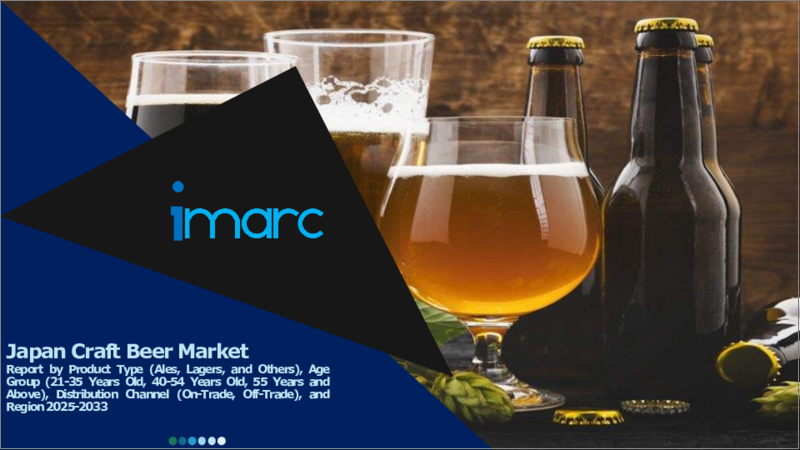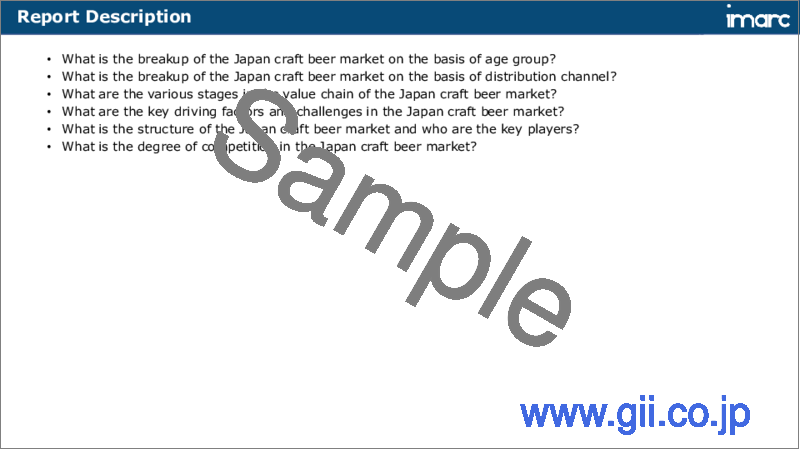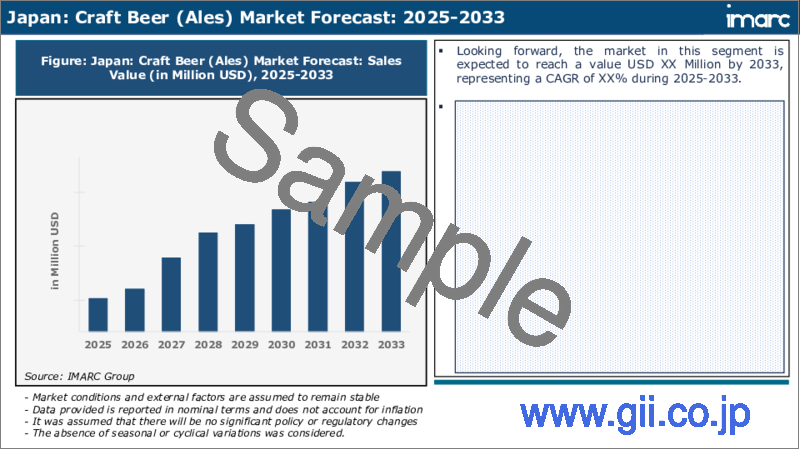|
|
市場調査レポート
商品コード
1729547
日本のクラフトビール市場レポート:製品タイプ、年齢層、流通チャネル、地域別、2025年~2033年Japan Craft Beer Market Report by Product Type (Ales, Lagers, and Others), Age Group (21-35 Years Old, 40-54 Years Old, 55 Years and Above), Distribution Channel (On-Trade, Off-Trade), and Region 2025-2033 |
||||||
カスタマイズ可能
|
|||||||
| 日本のクラフトビール市場レポート:製品タイプ、年齢層、流通チャネル、地域別、2025年~2033年 |
|
出版日: 2025年05月01日
発行: IMARC
ページ情報: 英文 121 Pages
納期: 5~7営業日
|
全表示
- 概要
- 目次
日本のクラフトビールの市場規模は2024年に80億米ドルに達しました。IMARC Groupは、2025年から2033年にかけての成長率(CAGR)は12.61%で、2033年には234億米ドルに達すると予測しています。アルコールの消費量の増加、バーやパブの数の増加、クラフトビール醸造所にプラットフォームを提供するクラフトビールイベントやフェスティバルの開催の増加が市場を牽引する主な要因のいくつかです。
本レポートで扱う主な質問
- 日本のクラフトビール市場はこれまでどのように推移してきたか?
- COVID-19が日本のクラフトビール市場に与えた影響は?
- 日本のクラフトビール市場の製品タイプ別区分は?
- 日本のクラフトビール市場の年齢層別区分は?
- 日本のクラフトビール市場の流通チャネル別区分は?
- 日本のクラフトビール市場のバリューチェーンにおける各段階とは?
- 日本のクラフトビール市場の主な促進要因と課題は何か?
- 日本のクラフトビール市場の構造と主要プレーヤーは?
- 日本のクラフトビール市場における競合の程度は?
目次
第1章 序文
第2章 調査範囲と調査手法
- 調査の目的
- ステークホルダー
- データソース
- 市場推定
- 調査手法
第3章 エグゼクティブサマリー
第4章 日本のクラフトビール市場:イントロダクション
- 概要
- 市場力学
- 業界動向
- 競合情報
第5章 日本のクラフトビール市場情勢
- 過去および現在の市場動向(2019~2024年)
- 市場予測(2025~2033年)
第6章 日本のクラフトビール市場:製品タイプ別の内訳
- エール
- ラガー
- その他
第7章 日本のクラフトビール市場:年齢層別の内訳
- 21~35歳
- 40~54歳
- 55歳以上
第8章 日本のクラフトビール市場:流通チャネル別の内訳
- オントレード
- オフトレード
第9章 日本のクラフトビール市場:競合情勢
- 概要
- 市場構造
- 市場企業のポジショニング
- 主要成功戦略
- 競合ダッシュボード
- 企業評価象限
第10章 主要企業のプロファイル
第11章 日本のクラフトビール市場:業界分析
- 促進要因、抑制要因、機会
- ポーターのファイブフォース分析
- バリューチェーン分析
第12章 付録
The Japan craft beer market size reached USD 8.0 Billion in 2024. Looking forward, IMARC Group expects the market to reach USD 23.4 Billion by 2033, exhibiting a growth rate (CAGR) of 12.61% during 2025-2033. The growing consumption of alcohol, rising number of bars and pubs, and increasing occurrence of craft beer events and festivals providing a platform for craft breweries represent some of the key factors driving the market.
Craft beer refers to a type of beer that is produced by independent breweries using traditional and innovative brewing methods. It is known for its emphasis on quality, flavor, and distinctiveness and made by selecting high-quality ingredients, such as malted grains (such as barley) and hops, which are milled and mixed with water and yeast to ferment and produce alcohol. It offers various options, including pale ales, India pale ale (IPAs), stouts, and porters. It can be enjoyed on its own or paired with a variety of foods, as it complements and enhances different flavors. It helps the agriculture sector to grow as hops and malts are used as raw materials that are grown and sold by local farmers. Furthermore, as craft beer contributes to local economies and promotes sustainability, its demand is increasing in Japan.
Japan Craft Beer Market Trends:
At present, the rising demand for craft beer due to the increasing consumer demand represents one of the crucial factors influencing the market positively in Japan. Moreover, the rising consumption of alcohol among the masses to cope with work-related stress, anxiety, and depression is strengthening the growth of the market in the country. Apart from this, the growing number of individuals showing a greater interest in craft beer and exploring different beer styles and flavors is offering a positive market outlook. Additionally, the rising occurrence of craft beer events and festivals providing a platform for craft breweries to showcase their products, create brand awareness, and engage directly with consumers is offering lucrative growth opportunities to industry investors in the country. In line with this, the increasing number of craft breweries sourcing their ingredients locally to maintain the high quality of beer is impelling the market growth in the country. Besides this, governing agencies are easing regulations and licensing requirements for craft breweries and providing financial assistance and tax incentives. In addition, the increasing number of craft beer manufacturers adopting sustainable measures to minimize wastage and reduce their carbon footprint is bolstering the growth of the market in the country. Furthermore, the rising number of restaurants, fast food centers, pubs, and bars serving premium quality craft beer to consumers is contributing to the growth of the market in Japan.
Japan Craft Beer Market Segmentation:
Product Type Insights:
- Ales
- Lagers
- Others
Age Group Insights:
- 21-35 Years Old
- 40-54 Years Old
- 55 Years and Above
Distribution Channel Insights:
- On-Trade
- Off-Trade
Competitive Landscape:
- The report has also provided a comprehensive analysis of the competitive landscape in the Japan craft beer market. Competitive analysis such as market structure, key player positioning, top winning strategies, competitive dashboard, and company evaluation quadrant has been covered in the report. Also, detailed profiles of all major companies have been provided.
Key Questions Answered in This Report:
- How has the Japan craft beer market performed so far and how will it perform in the coming years?
- What has been the impact of COVID-19 on the Japan craft beer market?
- What is the breakup of the Japan craft beer market on the basis of product type?
- What is the breakup of the Japan craft beer market on the basis of age group?
- What is the breakup of the Japan craft beer market on the basis of distribution channel?
- What are the various stages in the value chain of the Japan craft beer market?
- What are the key driving factors and challenges in the Japan craft beer market?
- What is the structure of the Japan craft beer market and who are the key players?
- What is the degree of competition in the Japan craft beer market?
Table of Contents
1 Preface
2 Scope and Methodology
- 2.1 Objectives of the Study
- 2.2 Stakeholders
- 2.3 Data Sources
- 2.3.1 Primary Sources
- 2.3.2 Secondary Sources
- 2.4 Market Estimation
- 2.4.1 Bottom-Up Approach
- 2.4.2 Top-Down Approach
- 2.5 Forecasting Methodology
3 Executive Summary
4 Japan Craft Beer Market - Introduction
- 4.1 Overview
- 4.2 Market Dynamics
- 4.3 Industry Trends
- 4.4 Competitive Intelligence
5 Japan Craft Beer Market Landscape
- 5.1 Historical and Current Market Trends (2019-2024)
- 5.2 Market Forecast (2025-2033)
6 Japan Craft Beer Market - Breakup by Product Type
- 6.1 Ales
- 6.1.1 Overview
- 6.1.2 Historical and Current Market Trends (2019-2024)
- 6.1.3 Market Forecast (2025-2033)
- 6.2 Lagers
- 6.2.1 Overview
- 6.2.2 Historical and Current Market Trends (2019-2024)
- 6.2.3 Market Forecast (2025-2033)
- 6.3 Others
- 6.3.1 Historical and Current Market Trends (2019-2024)
- 6.3.2 Market Forecast (2025-2033)
7 Japan Craft Beer Market - Breakup by Age Group
- 7.1 21-35 Years Old
- 7.1.1 Overview
- 7.1.2 Historical and Current Market Trends (2019-2024)
- 7.1.3 Market Forecast (2025-2033)
- 7.2 40-54 Years Old
- 7.2.1 Overview
- 7.2.2 Historical and Current Market Trends (2019-2024)
- 7.2.3 Market Forecast (2025-2033)
- 7.3 55 Years and Above
- 7.3.1 Overview
- 7.3.2 Historical and Current Market Trends (2019-2024)
- 7.3.3 Market Forecast (2025-2033)
8 Japan Craft Beer Market - Breakup by Distribution Channel
- 8.1 On-Trade
- 8.1.1 Overview
- 8.1.2 Historical and Current Market Trends (2019-2024)
- 8.1.3 Market Forecast (2025-2033)
- 8.2 Off-Trade
- 8.2.1 Overview
- 8.2.2 Historical and Current Market Trends (2019-2024)
- 8.2.3 Market Forecast (2025-2033)
9 Japan Craft Beer Market - Competitive Landscape
- 9.1 Overview
- 9.2 Market Structure
- 9.3 Market Player Positioning
- 9.4 Top Winning Strategies
- 9.5 Competitive Dashboard
- 9.6 Company Evaluation Quadrant
10 Profiles of Key Players
- 10.1 Company A
- 10.1.1 Business Overview
- 10.1.2 Product Portfolio
- 10.1.3 Business Strategies
- 10.1.4 SWOT Analysis
- 10.1.5 Major News and Events
- 10.2 Company B
- 10.2.1 Business Overview
- 10.2.2 Product Portfolio
- 10.2.3 Business Strategies
- 10.2.4 SWOT Analysis
- 10.2.5 Major News and Events
- 10.3 Company C
- 10.3.1 Business Overview
- 10.3.2 Product Portfolio
- 10.3.3 Business Strategies
- 10.3.4 SWOT Analysis
- 10.3.5 Major News and Events
- 10.4 Company D
- 10.4.1 Business Overview
- 10.4.2 Product Portfolio
- 10.4.3 Business Strategies
- 10.4.4 SWOT Analysis
- 10.4.5 Major News and Events
- 10.5 Company E
- 10.5.1 Business Overview
- 10.5.2 Product Portfolio
- 10.5.3 Business Strategies
- 10.5.4 SWOT Analysis
- 10.5.5 Major News and Events
11 Japan Craft Beer Market - Industry Analysis
- 11.1 Drivers, Restraints and Opportunities
- 11.1.1 Overview
- 11.1.2 Drivers
- 11.1.3 Restraints
- 11.1.4 Opportunities
- 11.2 Porters Five Forces Analysis
- 11.2.1 Overview
- 11.2.2 Bargaining Power of Buyers
- 11.2.3 Bargaining Power of Suppliers
- 11.2.4 Degree of Competition
- 11.2.5 Threat of New Entrants
- 11.2.6 Threat of Substitutes
- 11.3 Value Chain Analysis





